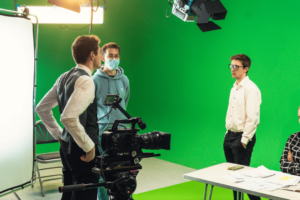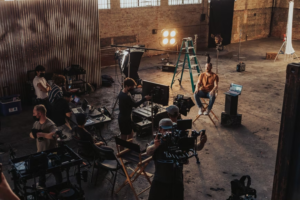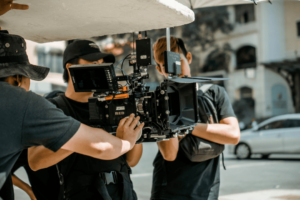Shooting images or video with a shallow depth of field is a technique that can contribute to the overall narrative being presented. Shallow depth of field refers to a plane that focuses on one particular object and allows everything else in the frame to be out of focus. In order to achieve the shallow depth of field technique, you must set your camera with a low f-number or f-stop, which lets in more light.
Successful Shallow Depth of Field
One of the key purposes behind using shallow depth of field when shooting images is to direct the viewer to what is important within the frame. Those viewing the image may wonder about what is blurred in the background, generating intrigue and adding depth as well.
What Is a Small Depth of Field?
Shallow depth of field and small depth of field are the same, and they may also be referred to as narrow or thin depths of field. In order to shoot with shallow depth of field, you must understand the aperture, which is a setting on your lens. Depth of field refers to the area of sharpness in an image, or how sharp or blurry the area surrounding a subject is in a photograph. The aperture controls the focus of an image by altering the opening size of the lens.
When Should I Use a Shallow Depth of Field?
With a shallow depth of field, the images you take will yield blurrier backgrounds with the subject more clearly in focus. You can achieve this photography technique by changing the distance between the camera and the subject and adjusting the lens focal length. This technique helps the subject stand out from the backdrop and works well for portrait, wildlife, and sports photography.
Depth of Field in Portraiture
Shallow depth of field often comes up when photographers are shooting portraits, where the subject in the photo is the main focus and anything in the background can be blurred for emphasis. If you choose to implement this technique when capturing portraits, try to focus on the subject’s eyes to create more of a connection between the subject and the viewer. In a portrait, shallow depth of field can eliminate any background details that may otherwise be distracting or pull the focus away from the person being photographed.
The f-stop you select on your camera will impact the outcome of the shallow depth of field. In an atmosphere with dim lighting, a setting of f/1.4 may be necessary to achieve enough ambient light to enhance the exposure. However, this setting could cause the subject to become blurred. Consider opening the f-stop to f/5.6 or f/8 to combat the problem and get your subject entirely within focus. The lighting of the setting also impacts what depth of field you can use when shooting portraits.
To Guide the Eye
Highlighting one aspect while gently blurring the rest of the objects or subjects in the image adds significance to the main subject. A shallow depth of field can also highlight something unexpected in a photograph or video. This is often called selective focus.
To Draw the Eye Away
Using blur to highlight a focal point also draws the eye away from anything distracting in the background or foreground.
How Do You Get a Shallow Depth of Field?
If you want to decrease the depth of field in your photos to create a shallower depth, consider these techniques:
Move the Camera Closer to the Subject
As you move the camera closer to the subject, the depth of field becomes more shallow. Positioning your camera this way naturally creates blur outside the subject, including in the background and foreground.
Keep Subjects Far Away From Each Other
Keeping distance between subjects decreases the depth of field and adds depth to the image.
Widen Your Aperture
Aperture is the light access provided through the lens to the sensors in the camera. The diameter of this hole controls how much light can come through the lens, so using a lower aperture number, or f-stop, allows you to maintain a smaller depth of field. Opening the aperture of your camera lens to a lower f-stop helps to decrease the depth of field. This does allow in more light, however, so be aware as you balance the exposure of the image.
Extend the Focal Length
If you have multiple lenses for your camera, using a longer lens can also help you achieve a shallow depth of field. If you don’t have multiple lenses or your camera doesn’t allow for interchangeable lenses, consider using the zoom feature with the camera mounted on a tripod to eliminate shake.
What If I Just Have a Point-and-Shoot Camera or Don’t Know How to Adjust Those Settings?
Even with a simple point-and-shoot camera, you should be able to adjust the depth of field in your mode settings. Look for a mode that has a symbol of a human face or head, which indicates the portrait setting and will provide a more narrow depth of field.
Challenges With Shallow Depth of Field
One of the common challenges associated with a shallow depth of field is overdoing it. When the field depth is too shallow, the photograph may lack development from a narrative sense, making it less interesting to the viewer. The background of an image can be as interesting as the subject, so allowing the viewer to somewhat see what sits behind the subject can create depth and interest. By subtly or softly blurring the backdrop, you can create the proper depth of field without making it too focused on one object or person.
Another challenge is ensuring that the field of focus on your camera is placed properly and set wide enough. Practice shooting several different shots at different f-stops to determine the width of the angle you want and what is in focus with each setting. After you find the right setting, you can manually focus on the subject and use the zoom functionality. Using the manual mode on your camera gives you more control over the shallow depth of field.
Can I Set the Depth of Field Exactly for Each Situation?
Yes, as long as you make the necessary adjustments to alter the depth of field before shooting. When shooting in a shallow depth of field, most photographers recommend skipping your wide-angle lens, as this piece of equipment is better suited to a deep depth of field. Using a wide-angle lens allows you to capture an entire scene in clear focus, such as for landscape photography. When you want to blur out elements in the backdrop, stick to a longer focal length instead.
Is Depth of Field Equally Distributed in the Front and Back of the Focus Point?
On most cameras, the standard setting is a distribution of about one-third in front of the focal point and two-thirds behind it. As you increase the focal length, the distribution evens out.
Use Depth of Field to Your Advantage
By gaining a better understanding of shallow depth of field and how it differs from deep depth of field, you can learn how to use it to enhance the quality of your videos and photos and to expand your skill set.
Examples of Shallow Depth of Field
Look at these examples of images with shallow depth of field to better understand what this technique can achieve.
How to Improve Your Focus
Mastering the art of the shallow depth of field is more technical in nature and often requires practice. Start in manual mode to get a feel for different f-stop settings and what each setting produces on your camera. You can take a photo of the same object or subject with different aperture settings and compare those images to assess the differences and learn more about the range of each. Look at the level of detail in each image you capture, and determine the level of detail you want in your shots.
If you’re interested in learning more about shallow depth of field and improving your photography and filmmaking skills, apply to the Nashville Film Institute today.















